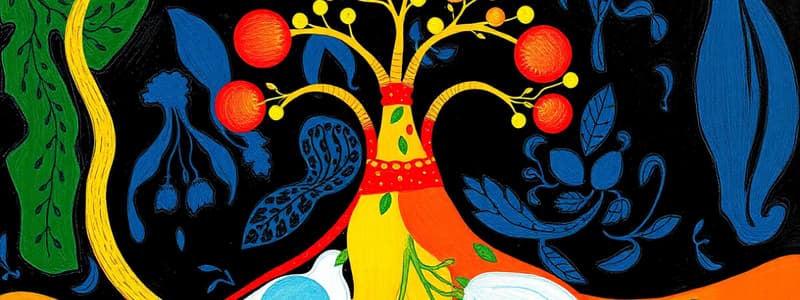Podcast
Questions and Answers
Which of the following is NOT a method of asexual reproduction?
Which of the following is NOT a method of asexual reproduction?
- Budding
- Spores
- Binary fission
- Cross-fertilization (correct)
Parthenogenesis is a reproduction method that requires fertilization.
Parthenogenesis is a reproduction method that requires fertilization.
False (B)
What is the primary advantage of sexual reproduction?
What is the primary advantage of sexual reproduction?
Genetic diversity
The offspring of K-strategists are typically ______ cared for by their parents.
The offspring of K-strategists are typically ______ cared for by their parents.
Match the following terms with their correct descriptions:
Match the following terms with their correct descriptions:
Which of the following is a common characteristic of sexual reproduction?
Which of the following is a common characteristic of sexual reproduction?
Meiosis results in four identical cells with half the chromosome count.
Meiosis results in four identical cells with half the chromosome count.
Name one example of a K-strategist.
Name one example of a K-strategist.
What is the main advantage of asexual reproduction?
What is the main advantage of asexual reproduction?
Parthenogenesis involves the merging of sperm and egg cells.
Parthenogenesis involves the merging of sperm and egg cells.
Name two methods of asexual reproduction.
Name two methods of asexual reproduction.
K-strategists typically produce ______ offspring that are cared for by parents.
K-strategists typically produce ______ offspring that are cared for by parents.
Which of the following statements correctly describes sexual reproduction?
Which of the following statements correctly describes sexual reproduction?
Match the following reproduction strategies with their characteristics:
Match the following reproduction strategies with their characteristics:
Meiosis results in four unique cells with half the chromosome number.
Meiosis results in four unique cells with half the chromosome number.
What is the role of courting behavior in sexual reproduction?
What is the role of courting behavior in sexual reproduction?
Which of the following is a method of asexual reproduction?
Which of the following is a method of asexual reproduction?
Parthenogenesis involves the fusion of sperm and egg cells.
Parthenogenesis involves the fusion of sperm and egg cells.
What type of organisms typically exhibit asexual reproduction?
What type of organisms typically exhibit asexual reproduction?
The process of reproduction that results in offspring that are genetically diverse is called ______.
The process of reproduction that results in offspring that are genetically diverse is called ______.
Match the reproduction strategies with their characteristics:
Match the reproduction strategies with their characteristics:
Which of the following statements is true regarding meiosis?
Which of the following statements is true regarding meiosis?
Asexual reproduction usually leads to greater genetic diversity compared to sexual reproduction.
Asexual reproduction usually leads to greater genetic diversity compared to sexual reproduction.
What is a common characteristic of sexual reproduction?
What is a common characteristic of sexual reproduction?
Flashcards are hidden until you start studying
Study Notes
Asexual Reproduction
- Produces clones; all offspring genetically identical to the parent.
- New individuals arise from a single cell or a part of the parent organism.
- Common in single-celled organisms, plants, and fungi.
- Different methods of asexual reproduction include:
- Binary fission: Single cell divides into two.
- Multiplication: Growth and division of cells.
- Budding: New organism develops from an outgrowth of the parent.
- Spores: Reproductive cells capable of developing into new individuals.
- Runners: Horizontal stems that produce new plants.
- Rhizomes: Underground stems that can grow into new plants.
- Root sprouts: New shoots from the parent plant’s roots.
- Regeneration: Ability to regrow lost or damaged parts.
Parthenogenesis
- Development of a new individual from an unreduced egg cell without fertilization.
- Common in colony-forming insects and some invertebrates.
- Offers efficiency as it does not require males for reproduction.
Sexual Reproduction
- Involves merging of gametes (sperm and egg cells) resulting in genetic diversity.
- Produces new individuals that are a mix of parental genes.
- Organisms can be:
- Unisexual: Individuals produce either sperm or egg cells.
- Hermaphrodites: Individuals produce both gametes and have both sex organs, e.g., earthworms.
Insemination
- Can occur through internal or external fertilization.
- Often involves courting behavior with female choice influencing mating dynamics.
Meiosis
- A type of nuclear division resulting in gametes.
- Produces four unique cells with half the chromosome count compared to mitosis, which creates two identical cells.
Comparison of Reproductive Strategies
-
Asexual Reproduction:
- No need to find a mate, leading to efficient reproduction.
- Utilizes fewer resources and allows for quick population growth.
- Can produce many offspring quickly, useful for colonization.
- Results in little genetic diversity, making survival in changing environments more challenging.
-
Sexual Reproduction:
- Involves more genetic variety, aiding adaptability and faster evolution.
- Requires time and resources to find mates, resulting in fewer offspring.
- Commonly associated with parental care for offspring survival.
Reproductive Strategies
-
K-strategists:
- Produce few offspring with high parental care.
- Most offspring survive to reproductive age; seen in top predators.
-
R-strategists:
- Produce many offspring but provide little to no parental care.
- Most offspring do not survive to adulthood; exemplified by species that rely on quantity over quality.
Asexual Reproduction
- Produces clones; all offspring genetically identical to the parent.
- New individuals arise from a single cell or a part of the parent organism.
- Common in single-celled organisms, plants, and fungi.
- Different methods of asexual reproduction include:
- Binary fission: Single cell divides into two.
- Multiplication: Growth and division of cells.
- Budding: New organism develops from an outgrowth of the parent.
- Spores: Reproductive cells capable of developing into new individuals.
- Runners: Horizontal stems that produce new plants.
- Rhizomes: Underground stems that can grow into new plants.
- Root sprouts: New shoots from the parent plant’s roots.
- Regeneration: Ability to regrow lost or damaged parts.
Parthenogenesis
- Development of a new individual from an unreduced egg cell without fertilization.
- Common in colony-forming insects and some invertebrates.
- Offers efficiency as it does not require males for reproduction.
Sexual Reproduction
- Involves merging of gametes (sperm and egg cells) resulting in genetic diversity.
- Produces new individuals that are a mix of parental genes.
- Organisms can be:
- Unisexual: Individuals produce either sperm or egg cells.
- Hermaphrodites: Individuals produce both gametes and have both sex organs, e.g., earthworms.
Insemination
- Can occur through internal or external fertilization.
- Often involves courting behavior with female choice influencing mating dynamics.
Meiosis
- A type of nuclear division resulting in gametes.
- Produces four unique cells with half the chromosome count compared to mitosis, which creates two identical cells.
Comparison of Reproductive Strategies
-
Asexual Reproduction:
- No need to find a mate, leading to efficient reproduction.
- Utilizes fewer resources and allows for quick population growth.
- Can produce many offspring quickly, useful for colonization.
- Results in little genetic diversity, making survival in changing environments more challenging.
-
Sexual Reproduction:
- Involves more genetic variety, aiding adaptability and faster evolution.
- Requires time and resources to find mates, resulting in fewer offspring.
- Commonly associated with parental care for offspring survival.
Reproductive Strategies
-
K-strategists:
- Produce few offspring with high parental care.
- Most offspring survive to reproductive age; seen in top predators.
-
R-strategists:
- Produce many offspring but provide little to no parental care.
- Most offspring do not survive to adulthood; exemplified by species that rely on quantity over quality.
Asexual Reproduction
- Produces clones; all offspring genetically identical to the parent.
- New individuals arise from a single cell or a part of the parent organism.
- Common in single-celled organisms, plants, and fungi.
- Different methods of asexual reproduction include:
- Binary fission: Single cell divides into two.
- Multiplication: Growth and division of cells.
- Budding: New organism develops from an outgrowth of the parent.
- Spores: Reproductive cells capable of developing into new individuals.
- Runners: Horizontal stems that produce new plants.
- Rhizomes: Underground stems that can grow into new plants.
- Root sprouts: New shoots from the parent plant’s roots.
- Regeneration: Ability to regrow lost or damaged parts.
Parthenogenesis
- Development of a new individual from an unreduced egg cell without fertilization.
- Common in colony-forming insects and some invertebrates.
- Offers efficiency as it does not require males for reproduction.
Sexual Reproduction
- Involves merging of gametes (sperm and egg cells) resulting in genetic diversity.
- Produces new individuals that are a mix of parental genes.
- Organisms can be:
- Unisexual: Individuals produce either sperm or egg cells.
- Hermaphrodites: Individuals produce both gametes and have both sex organs, e.g., earthworms.
Insemination
- Can occur through internal or external fertilization.
- Often involves courting behavior with female choice influencing mating dynamics.
Meiosis
- A type of nuclear division resulting in gametes.
- Produces four unique cells with half the chromosome count compared to mitosis, which creates two identical cells.
Comparison of Reproductive Strategies
-
Asexual Reproduction:
- No need to find a mate, leading to efficient reproduction.
- Utilizes fewer resources and allows for quick population growth.
- Can produce many offspring quickly, useful for colonization.
- Results in little genetic diversity, making survival in changing environments more challenging.
-
Sexual Reproduction:
- Involves more genetic variety, aiding adaptability and faster evolution.
- Requires time and resources to find mates, resulting in fewer offspring.
- Commonly associated with parental care for offspring survival.
Reproductive Strategies
-
K-strategists:
- Produce few offspring with high parental care.
- Most offspring survive to reproductive age; seen in top predators.
-
R-strategists:
- Produce many offspring but provide little to no parental care.
- Most offspring do not survive to adulthood; exemplified by species that rely on quantity over quality.
Studying That Suits You
Use AI to generate personalized quizzes and flashcards to suit your learning preferences.




